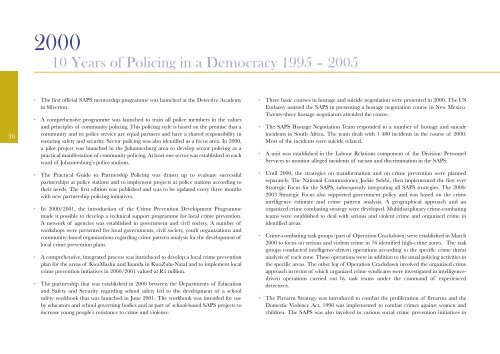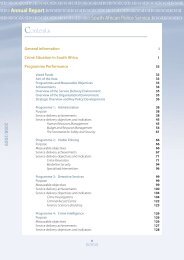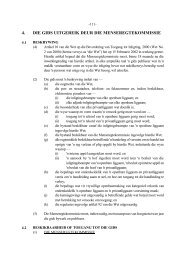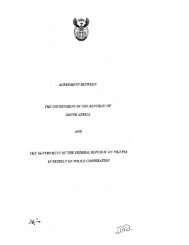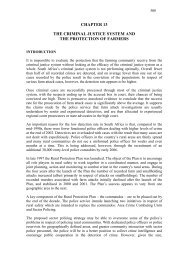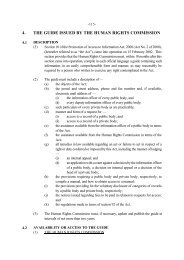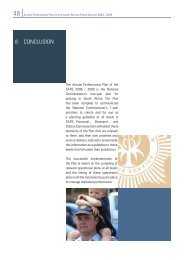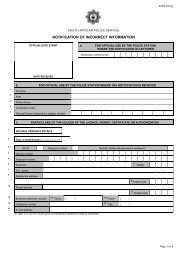Untitled - Saps
Untitled - Saps
Untitled - Saps
You also want an ePaper? Increase the reach of your titles
YUMPU automatically turns print PDFs into web optimized ePapers that Google loves.
2000<br />
10 Years of Policing in a Democracy 1995 – 2005<br />
36<br />
• The first official SAPS mentorship programme was launched at the Detective Academy<br />
in Silverton.<br />
• A comprehensive programme was launched to train all police members in the values<br />
and principles of community policing. This policing style is based on the premise that a<br />
community and its police service are equal partners and have a shared responsibility in<br />
ensuring safety and security. Sector policing was also identified as a focus area. In 2000,<br />
a pilot project was launched in the Johannesburg area to develop sector policing as a<br />
practical manifestation of community policing. At least one sector was established in each<br />
ward of Johannesburg’s police stations.<br />
• The Practical Guide to Partnership Policing was drawn up to evaluate successful<br />
partnerships at police stations and to implement projects at police stations according to<br />
their needs. The first edition was published and was to be updated every three months<br />
with new partnership policing initiatives.<br />
• In 2000/2001, the introduction of the Crime Prevention Development Programme<br />
made it possible to develop a technical support programme for local crime prevention.<br />
A network of agencies was established in government and civil society. A number of<br />
workshops were presented for local governments, civil society, youth organizations and<br />
community-based organizations regarding crime pattern analysis for the development of<br />
local crime prevention plans.<br />
• A comprehensive, integrated process was introduced to develop a local crime prevention<br />
plan for the areas of KwaMashu and Inanda in KwaZulu-Natal and to implement local<br />
crime prevention initiatives in 2000/2001 valued at R1 million.<br />
• The partnership that was established in 2000 between the Departments of Education<br />
and Safety and Security regarding school safety led to the development of a school<br />
safety workbook that was launched in June 2001. The workbook was intended for use<br />
by educators and school governing bodies and as part of school-based SAPS projects to<br />
increase young people’s resistance to crime and violence.<br />
• Three basic courses in hostage and suicide negotiation were presented in 2000. The US<br />
Embassy assisted the SAPS in presenting a hostage negotiation course in New Mexico.<br />
Twenty-three hostage negotiators attended the course.<br />
• The SAPS Hostage Negotiation Team responded to a number of hostage and suicide<br />
incidents in South Africa. The team dealt with 1 480 incidents in the course of 2000.<br />
Most of the incidents were suicide related.<br />
• A unit was established in the Labour Relations component of the Division: Personnel<br />
Services to monitor alleged incidents of racism and discrimination in the SAPS.<br />
• Until 2000, the strategies on transformation and on crime prevention were planned<br />
separately. The National Commissioner, Jackie Selebi, then implemented the first ever<br />
Strategic Focus for the SAPS, subsequently integrating all SAPS strategies. The 2000-<br />
2003 Strategic Focus also supported government policy and was based on the crime<br />
intelligence estimate and crime pattern analysis. A geographical approach and an<br />
organized crime combating strategy were developed. Multidisciplinary crime-combating<br />
teams were established to deal with serious and violent crime and organized crime in<br />
identified areas.<br />
• Crime-combating task groups (part of Operation Crackdown) were established in March<br />
2000 to focus on serious and violent crime in 76 identified high-crime zones. The task<br />
groups conducted intelligence-driven operations according to the specific crime threat<br />
analysis of each zone. These operations were in addition to the usual policing activities in<br />
the specific areas. The other leg of Operation Crackdown involved the organized crime<br />
approach in terms of which organized crime syndicates were investigated in intelligencedriven<br />
operations carried out by task teams under the command of experienced<br />
detectives.<br />
• The Firearm Strategy was introduced to combat the proliferation of firearms and the<br />
Domestic Violence Act, 1998 was implemented to combat crimes against women and<br />
children. The SAPS was also involved in various social crime prevention initiatives in


